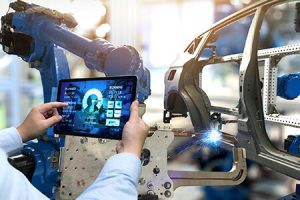 Convergence between the automotive and high-tech sectors isn’t a theory or prediction any more. Vehicles are as connected as smartphones, programmed with millions more lines of code than any computer, and increasingly powered by the same electric components and batteries – just on a much larger scale.
Convergence between the automotive and high-tech sectors isn’t a theory or prediction any more. Vehicles are as connected as smartphones, programmed with millions more lines of code than any computer, and increasingly powered by the same electric components and batteries – just on a much larger scale.
Automotive executives and shareholders now fish in the same pond as tech venture capitalists, on the hunt for processing power, artificial intelligence and data analytics. They speak the same language, too, around disruption, autonomy and the sharing economy, while start-ups or spin-offs in these areas can attract higher valuations than traditional manufacturers with large global footprints.
This shift in technology and capital is also transforming supply chains. Carmakers must source and serve new products across changing geographies, while handling different component types and configurations. Digital tools are also automating and optimising freight planning and execution.
However, the speed of change will vary by market or product strategy and should not be exaggerated. The huge logistical demands and costs for vehicle assembly have yet to disappear; if anything, they are more complex. Uncertainties over trade policy post-Brexit, or tariffs imposed by the US on Mexico, China and others, for example, pose uneasy questions about supply chains that have grown so entwined.
The logistical oath
The Silicon Valley culture of fast failure, risky investment and extreme flexibility does not always sit comfortably with lean, just-in-time production. Relatively few logistics departments or companies have the budgets or margins to incubate new business models. The commitment they make to their operations or customers is more Hippocratic than disruptive: do no harm, stop no line, delay no launch, increase no costs.
And yet, those who lead logistics must find a balance between fulfilling traditional operational needs and managing new, riskier supply chains while pursuing fresh opportunities. That might mean obtaining certification to handle hazardous material for lithium-ion batteries, or investing in systems to capture more data from assets in transit.
Convergence with the tech industry has also turned up the volume on hype, whether over the shiniest new software or the demise of existing business models. That can make it hard for businesses to hear what is really important for their investment decisions, amid a clamour of noise that will eventually fade away.
Both Ti and Automotive Logistics strive to make sense out of the din, and the Automotive Supply Chain and Logistics 2018 report is a particularly important guide.
In analysing the industry’s current framework and benchmarking logistics across markets, OEMs and service providers, it identifies trends and changes across the supply chain, from trucking patterns and packaging to component architectures and new models for sourcing freight. It reveals that while many companies value stability over disruption, if they do not act now, harm may well come soon to them.


























![Global[1]](https://d3n5uof8vony13.cloudfront.net/Pictures/web/a/d/s/global1_726550.svgz)









